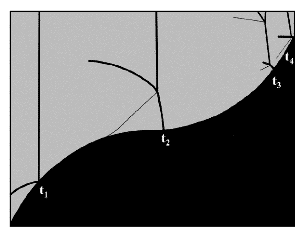ABSTRACT
The reflection pattern over a convex cylindrical surface followed by a concave cylindrical surface is studied using a high spatial resolution and high temporal resolution experimental setup. This fully automated setup enabled achieving high spatial resolution by using a 16.2 mega pixels SLR camera. The high temporal resolution was achieved by repeating the experiments many times while retaining extremely high repeatability. For the moderate shock strengths tested (1.2-1.4), the repeatability was less than 0.01 in the incident shock wave Mach number. Each experiment produced a single schlieren image with a pixel size of 0.03 mm. Thus, it was possible to distinguish minuscule flow features of size 0.06 mm. All images were later combined into a detailed description of a single reflection process. The process was analyzed using an automatic image processing procedure that located the triple point in each image [4]. The tested model enabled studying both the evolution of RR→MR transition over the convex segment and the evolution of a complicated shock pattern reflection over the concave part. It was found that the RR→MR non-stationary transition is closer to the pseudo-steady criterion in comparison to previous experimental studies [3]. Yet, based on error estimation analysis, and in contrast to [5], the pseudo-steady criterion will remain 3o-8o higher than the dynamic transitions investigated. Over the concave segment we observed the evolution of a newly three shock configuration established on the Mach stem of the original reflection (MRMR). This double Mach configuration explains the enhancement in the pressure when using blunt entry reflectors [1, 2]. The transition of the newly formed MR to regular reflection (MRRR) was also investigated. The reflection process over the concave segment depends on the first reflection process. Since the later dictates a specific relative angle between the incident shock wave and the original Mach stem. This angle can be later used to adjust the MRMR→MRRR transition angles. Even though this three shock configuration originated from the Mach stem, it was found that the adjusted transition angles were close to the MR→RR transition angles reported in the literature [3].

Figure 1: Illustration of the reflection process over the model. At t1, the shock interacts with a large angle resulting in an RR. At t2, the configuration transforms to an MR as a result of a decrease in the surface angle. The configuration continues to reflect over the concave segment. At t3, a secondary MR is formed on the original Mach stem. This MR will later, as the surface angle increases, transitions to an RR (not seen in the figure).
REFERENCES
1. BABINSKY, H., ONODERA, O., TAKAYAMA, TIMOFEEV, E, VOINOVICH, P. 1995 The influence of geometric variations on shock focusing in cylindrical cavities. Proc. 20th Int. Symp. Shock Waves, Pasadena, California, U.S.A., 495-500.
2. BABINSKY, H., ONODERA, O., TAKAYAMA, K., SAITO, T., VOINOVICH, P., TIMOFEEV, E. 1998 The influence of entrance geometry of circular reflectors on the shock wave focusing. Comp. & Fluids 27(5-6):611-618. Springer, NY, (1990).
3. BEN-DOR G. 2007 Shock Wave Reflection Phenomena. Springer, Berlin; New York
4. GEVA M., RAM O., SADOT O. 2013 The non-stationary hysteresis phenomenon in shock wave reflections. J. Fluid Mech. 732:1-11.
5. KLEINE H., TIMOFEEV E., HAKKAKI-FARD A., SKEWS B. 2014 The influence of Reynolds number on the triple point trajectories at shock reflection off cylindrical surfaces. J. Fluid Mech. 740:47-60.

